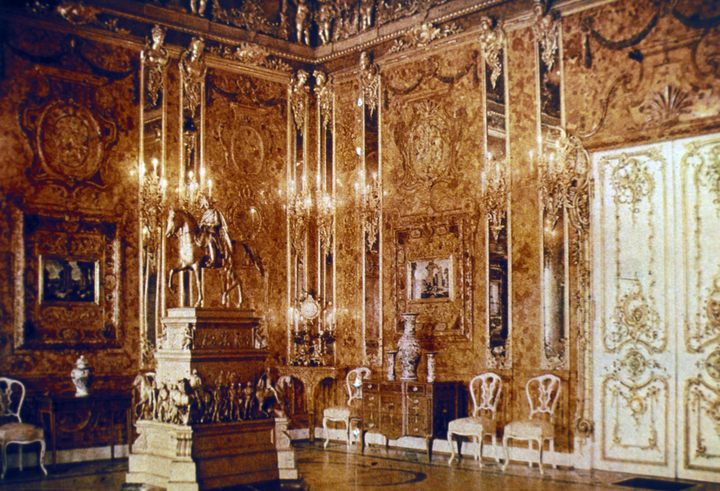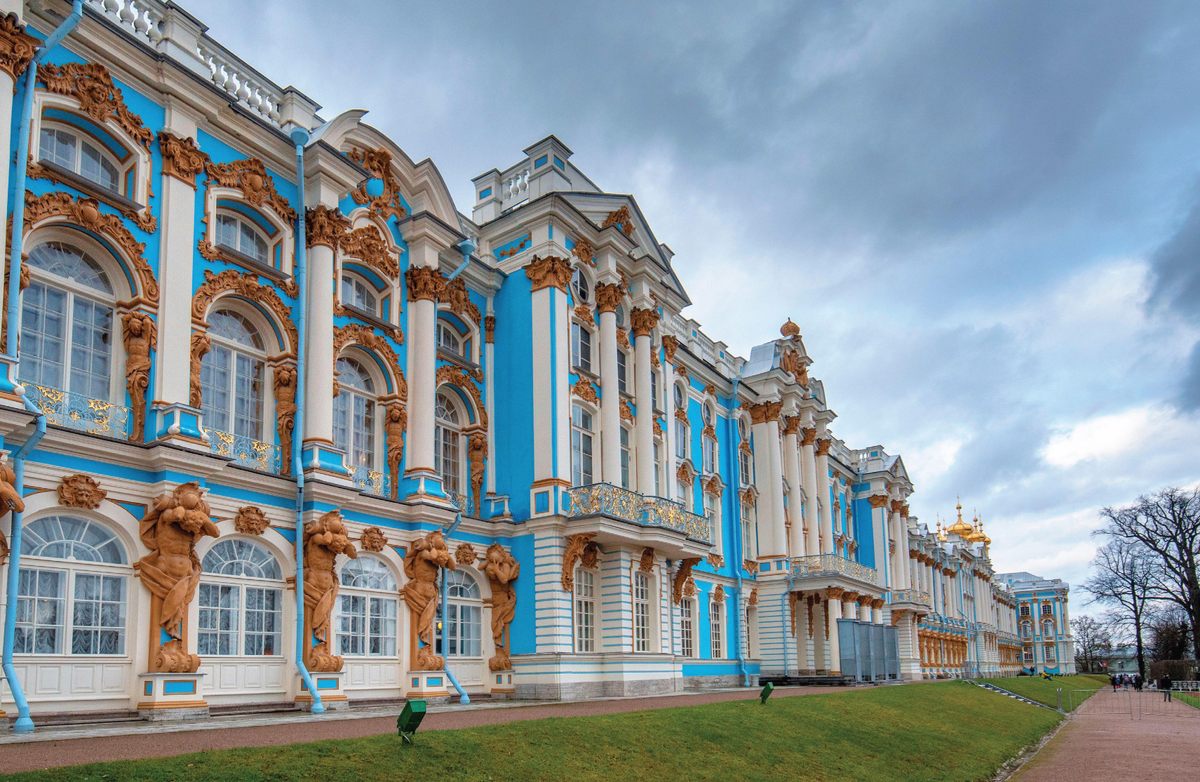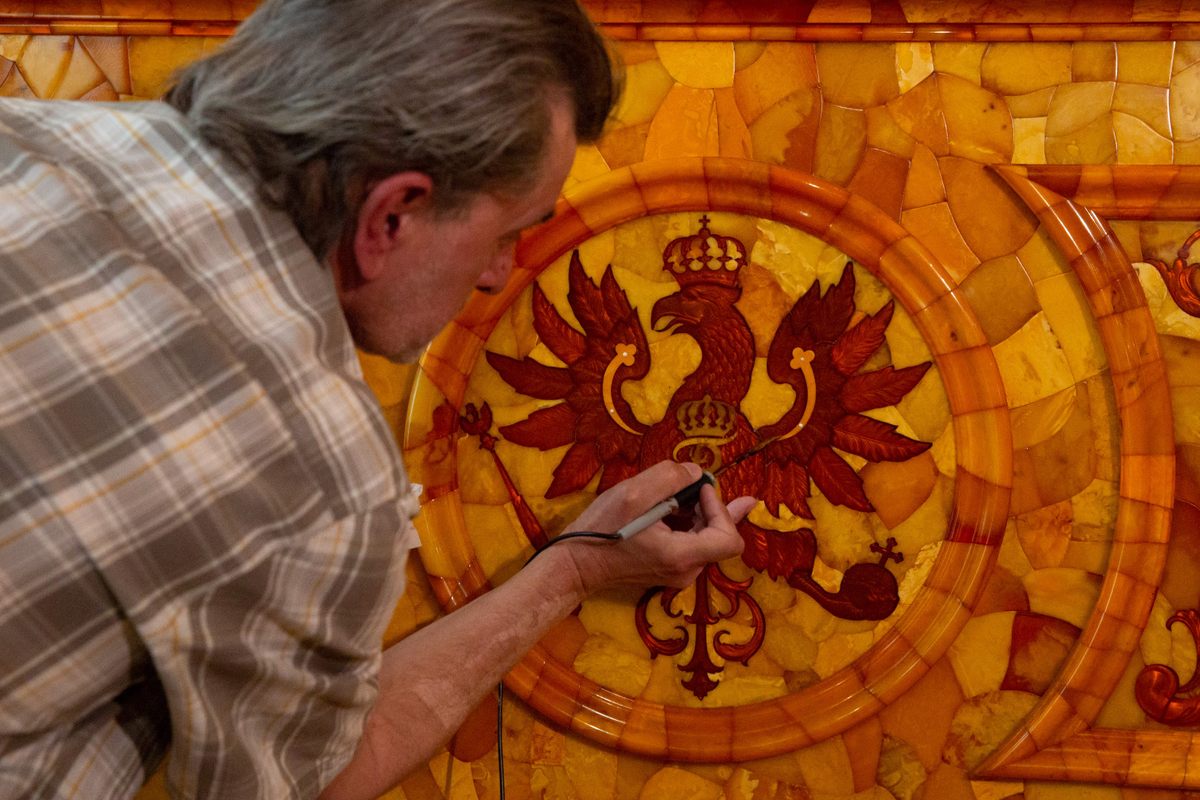
The Enduring Mystery of the Amber Room, Coveted by Tsars, Nazis, and Treasure Hunters
Crafted from amber and gold, it enthralled all who saw it. Then, near the end of World War II, it disappeared.
Excerpted and adapted with permission from The Secret Life of Hidden Places: Concealed Rooms, Clandestine Passageways, and the Curious Minds That Made Them, by Stefan Bachmann and April Genevieve Tucholke, published February 2024 by Workman Books. All rights reserved.
Birds nest beneath the painted clouds of the ruined galleries. Soldiers mill across the parquet or sleep on divans where, thirty years before, the Romanov children argued and played and daydreamed. Dirty boots scuff threadbare satin and portrait halls are repurposed as troop quarters. Their uniforms are gray wool, a black eagle clutching a wreath, a hooked double cross. The Nazis have reached Russia. They’ve taken the Catherine Palace and are waiting for orders from Berlin.
One room stands in stark contrast to the others’ splendor. The floor is covered in sand, the walls hastily hidden behind masses of rag pulp and cloth. But the disguise is being picked at.
Soldiers pull at the wall coverings. And suddenly, in the dimness, there is a faint glimmer, not gold, but deeper, richer: carved garlands of acanthus leaves, rosettes, mirrors, mosaics made of agate, onyx, and lapis, and panel upon panel of softly shimmering, lustrous brown gems, their colors whirling, like a drop of milk in tea, like perfectly glazed pastry. The room seems to radiate its own light, from lemon to honey to coffee, a thousand tones of warmth.
A short time later, there is nothing left of the extraordinary room, glowing like warm honey, like the final embers of life in the desolate, gutted palace. There is only a hollow, empty shell. The soldiers have left and the famous Amber Room has left with them.

Friedrich Wilhelm I, King of Prussia, a man whose greatest hobby consisted of kidnapping giants from London and Vienna and forcing them into service as his personal bodyguards, was not what you’d call an artistic sort of fellow. He was miserly, rough mannered, obsessed with military protocol, and did not like to read. He loved his wife but despised what he considered her idle affection for painting and music.
It was under this unpromising star, however, that one of the most enduring and fascinating pieces of art of the last 400 years first appeared on the world’s stage: a jewel box of a room so bursting with beauty and detail that it boggles the mind. Théophile Gautier described it in his book Voyage en Russie as something from a fairy tale or The Thousand and One Nights. “The eye,” he wrote, “is amazed and blinded by the wealth and warmth of tints, representing all colors of the spectrum of yellow—from smoky topaz to a light lemon.”
The Amber Room was visited by thousands during its heyday, admired and envied, moved between multiple royal courts, used as a tsarina’s personal wellness room, and as a political chess piece to broker alliances between nations. Everyone who saw it had something to say about it. A German chambermaid glimpsed it and sent an awestruck letter back to her lover in Weimar, writing breathlessly of an indescribably beautiful room whose “price could never be calculated.” Contemporaries named it the eighth wonder of the world. But today the Amber Room is a room lost in layers of time, obscured by the flames and political paperwork of a great war. It had a long, eventful existence, traveled further than most rooms do, and was last seen in Königsberg, now Kaliningrad, Russia, in 1944, just before the city was carpet-bombed into oblivion. Then it vanished, leaving a thousand traces in its wake.
What became of Friedrich Wilhelm’s fabled fairy-tale room?
Alfred Rohde, the director of the Königsberg museum where it was last housed, swore to his superior that the room’s amber panels had been rescued from the bombs, yet weeks before told a family friend that they had been destroyed. In Bremen in 1997, a mysterious “Mr. X” attempted to sell one of the room’s four colored marble mosaics, causing a sensation and swift government intervention. A decade earlier, in a Bavarian wood, a treasure hunter who had dedicated years of his life to searching for the room was found ritualistically disemboweled, fueling rumors of Soviet assassinations and cover-ups. The room’s story is long, winding, and still unfinished, but to understand even a sliver of its legend we have to go back to the very beginning.
The Amber Room first began to take shape in the workshop of Andreas Schlüter, court architect to Frederick I, the father of the aforementioned artistically challenged Prussian king. Baltic amber, fossilized prehistoric tree sap that can be polished to an array of lovely hues, had begun to be stockpiled in Danzig during the 1600s, and in 1701 it was decided that something should be done to showcase these gems. Work began on a Bernstein-Kabinett, or amber cabinet, taking 13 years and multiple master craftsmen to complete.
The room was first installed, rather inauspiciously, in a corner of the third floor of the Berliner Stadtschloss. It had only been there a handful of years before it caught the eye of the visiting Peter the Great, Tsar of Russia. The tsar, along with bringing the Prussian king another giant for his collection, was there for business and personal gain. Well aware of Friedrich Wilhelm’s wish to secure his aid against Sweden, he took full advantage of the situation and made a point of loudly admiring all the things he wanted for himself, including the dazzling new Amber Room. Friedrich Wilhelm took the hint and, preferring troops over a frivolous piece of art any day, gifted the tsar the room along with a yacht. The alliance was made and the room was packed up. It would not see Germany again for three centuries.

In early 1717, the room arrived by sled in St. Petersburg, where it was installed in the old Winter Palace. Then, in 1755, when the Russian court moved out of the city, the room went with it, to the Catherine Palace in Tsarskoye Selo, or Tsar’s Village.
In the Catherine Palace, there was a slight problem: The designated space for the Amber Room was six times the size of the original humble cabinet. Not wanting to spread the grandeur too thin, the tsar ordered that it be expanded. Here is where it transformed into a true masterpiece. Two Italian architects took on the task of extending the amber panels, decking the room out with Venetian mirrors, gilded figures, Florentine mosaic panels, and mother-of-pearl inlays, and turning the little cabinet into the most majestic of the state rooms. Nine hundred and ninety pounds of amber became 13,000 pounds. Even the floor was a work of art, inlaid with 15 sorts of wood. finished, it became Catherine the Great’s favorite room in the palace, one she used both for gatherings with her inner circle and for her personal meditations. By candlelight, the amber conjured a warmth that no other room in the palace could replicate. During an endlessly gloomy Russian winter, the room might have been the equivalent of a SAD lamp or wearing orange-tinted spectacles. Perhaps adding to its appeal, amber was considered healthful at the time, a wonder cure for a host of ailments. The room passed unscathed through the rise and fall of multiple monarchs, as well as the bloody Bolshevik revolution. Then, in 1941, Hitler’s Operation Barbarossa knocked at the doors of the Soviet Union.
With enemy troops swiftly approaching St. Petersburg and the Tsar’s Village, the palace caretakers were thrown into a panic. Anatoly Mikhailovich Kuchumov, a young museum curator, deemed the room far too large and heavy to be moved. Over the centuries the amber had grown brittle, and it was decided it could no longer be taken down for fear of ruining it. So Kuchumov had it glued with cloth and padding, and the floor covered in sand in a futile attempt to disguise it from the Germans.

In September 1941, German troops arrived at the deserted palace. The Amber Room’s disguise did little to fool them. A pair of soldiers found the panels under the covering. Within 36 hours the room had been packed up and sent by train toward the Baltic Sea. (How the Nazis managed to dismantle the room and spirit it away more or less undamaged, while Kuchumov and his staff could not, is a question that appears to have haunted the Russian curator for the rest of his life. He never stopped hunting for the room.)
In the autumn of that year, the room took its final known journey, arriving in Königsberg on October 17, 1941. Over the next few months Rohde had the room reassembled on the upper floor of the Palace of the Teutonic Knights, also known as Königsberg Castle, a fortress at the center of the city’s historic quarter. Rohde was an expert on amber art and had campaigned for the Amber Room to be saved and sent to him.
On November 13, 1941, the Königsberger Allgemeine Zeitung carried the headline “Amber Walls in the Palace” and the display was opened to the public. The room was a sensation and a brazen propaganda tool: If you could steal the Amber Room from under the Soviets’ noses, their troops would soon be defeated, too. But behind the scenes, the war was not going well. Superiors in Berlin were concerned with losing ground—and loot—to the Allies. The room was soon dismantled again, and packed into crates.

Near the end of August 1944, Königsberg was bombed extensively by the Soviets in retribution for bombings in Moscow. A family friend of Rohde’s, Liesl Amm, remembers going into the town by bicycle the next morning to ensure the survival of her friends and family. She met Rohde in the ruins of the castle courtyard. He took her to the basement where it was claimed the Amber Room panels had been stored for safekeeping. In an interview with Anthony Wilson in his documentary In Search of the Amber Room, Liesl spoke of a honey-like mass covering the stones. “It’s all gone,” she remembers Rohde telling her.
Then, curiously, on September 2, 1944, Rohde wrote to his superior in Berlin claiming that “The Amber Room has survived, apart from six dado panels.” Rohde’s son remembers his father telling him that the Amber Room had been “moved to a safe place.”
So did Amm misremember the scene in the ruins of the castle? Or did Rohde lie to her? Or was the room only partially destroyed and Rohde led Liesl to believe it had been destroyed in its entirety? There are myriad reasons why Rohde might want to obscure the truth about the fate of the room. If it was destroyed, nobody wanted to be blamed, certainly not Rohde, whose pride and joy was his museum and its exhibitions. And if it had survived, the patriotic German would not have wished to give up this information to the Soviets or to anyone but his closest confidants and family. Some claim he managed to get it out of the city and took the secret of its location to his grave. Others say that the room was so heavily damaged by smoke in one of the initial attacks on the city that Rohde hid it away out of shame for failing to protect it. According to this theory, the unrecognizably scarred panels were eventually burned as rubbish.

Yet another theory claims that the room, having survived the bombing and invasion of Königsberg by the Soviets, was then accidentally torched by Russian soldiers in celebration of their victory. This would not have been something the Soviets would have readily admitted to, and theories persist that they falsified statements and documents, and strategically kept the hope of the room’s existence alive, both to avoid responsibility for its embarrassing loss and also to aid in claims for restitution against Germany in the decades following the war. The Soviets also looted artwork from Germany during World War II, some say as many as 1.6 million pieces, and as long as the Germans were responsible for the loss of the priceless Amber Room, talks of restitution might remain one-sided.
Conspiracy theories began to proliferate. What better way, it was whispered, to stop speculation on the whereabouts of what was called the eighth wonder of the world than to say that it has been annihilated? There are hypotheses of billionaires with parts of the Amber Room paneling their yachts, of Stalin having replaced the crates containing the room with decoys and rushing away with the real room at the eleventh hour. People claimed to be neighbors, friends, or descendants of soldiers who had wired the bombs used to destroy the Amber Room.
There were wild rumors of a curse, with a trail of corpses left in the missing room’s wake. Rohde and his wife died of typhus in postwar Kaliningrad while the KGB was investigating the fate of the room; the doctor who signed their death certificates supposedly was never heard from again. General Gusev, a Russian intelligence officer, was killed in a car crash after being interviewed by a journalist about the Amber Room. Amber Room hunter Georg Stein died gruesomely in 1987 in a Bavarian forest, purportedly laid open with a scalpel—though others say he died of a gunshot wound to the head. Some claimed Stein was killed by Soviets trying to keep him from revealing information about the Amber Room, others that he had committed suicide out of disappointment over discovering the room was gone forever.
The legend of the Amber Room persists because there are just enough conflicting reports and tantalizingly obscured trails to set imaginations alight. Over the past decade alone, headlines have trumpeted the news that treasure hunters have found the priceless room or pieces of it. The mysterious Mr. X in Bremen, who attempted to sell one of the mosaics, turned out to be Hans Achterman, the son of a Wehrmacht truck driver who claimed to have helped pack the room during one of its many escapes. (The mosaic hung above the man’s couch in his apartment for years before being relegated to the basement. The son told reporters he did not like the look of it.)
There are compelling reasons to believe the room might have escaped the conflagration at Königsberg. The Nazis were known to hide valuable items across the globe in an attempt to confuse pursuers, such as the Minden, scuttled near Iceland with $110 million worth of gold from the Dresden Bank in its belly. In 2020, the Karlsruhe was found sunk off the coast of Poland containing military vehicles and crates that could possibly hold remnants of the amber panels.
It’s entirely possible the room is still out there but its story may also turn out to be comparable, in the end, to the search for Anastasia, Grand Duchess of Russia and youngest daughter of Tsar Nicholas II. Long rumored to have survived her family’s bloody assassination in 1918, the search for her lasted nearly a century and featured a steady string of impersonators, false claims, and wild theories. The truth was that Anastasia died in Yekaterinburg together with her family, but as long as there was some doubt, legend persisted that she had escaped.

Where there is no body and no answers, all answers are possible and our collective imagination runs wild. It’s why cold cases are more exciting than closed ones, and why lost treasures have the power to fascinate while those found might garner barely a glance in a crowded museum exhibition.
A reproduction of the Amber Room exists today. Artisans have built a version of it in the Catherine Palace using the same techniques as the amber craftsmen of the 1700s. (It is a wonder of its own, made possible through a financial alliance between Germany and Russia.)
But the real Amber Room, the one whose panels soaked in the perfumes of Catherine the Great and echoed the voices of the greatest minds and leaders of Europe, that room remains lost. Perhaps it is gone forever, lying at the bottom of an ocean, slowly succumbing to seawater and decay. And maybe it’s just as well it has a little peace now. The room has seen wars and bloodshed aplenty.





















Follow us on Twitter to get the latest on the world's hidden wonders.
Like us on Facebook to get the latest on the world's hidden wonders.
Follow us on Twitter Like us on Facebook